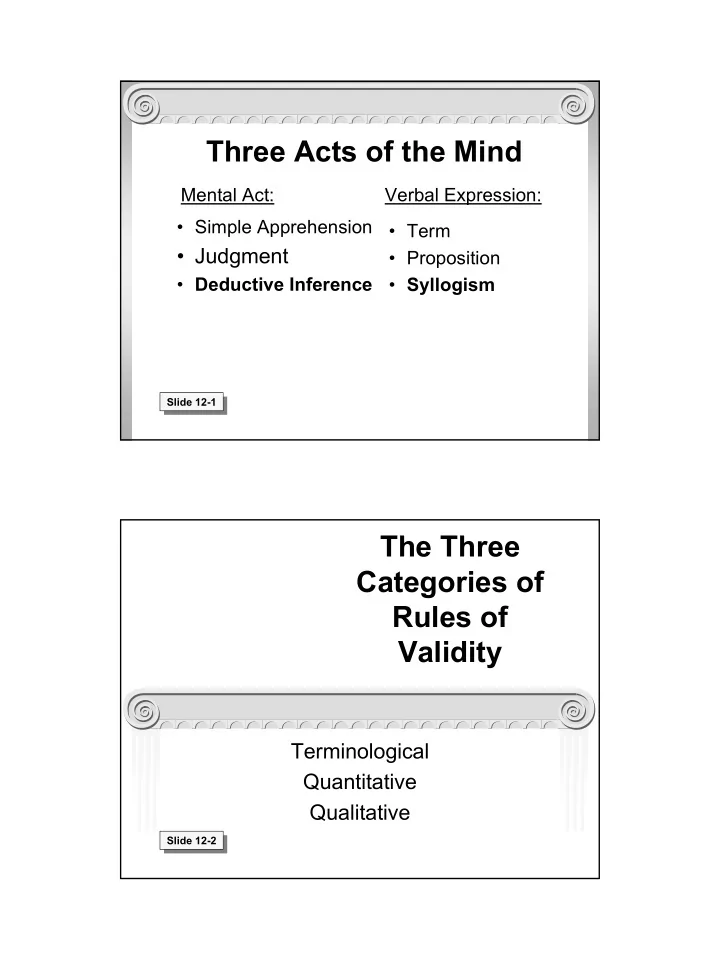

Three Acts of the Mind Mental Act: Verbal Expression: • Simple Apprehension • Term • Judgment • Proposition • Deductive Inference • Syllogism Slide 12-1 The Three Categories of Rules of Validity Terminological Quantitative Qualitative Slide 12-2 1
Quantitative Rules of Validity III. If a term is distributed in the conclusion, then it must be distributed in the premises. IV. The middle term must be distributed at least once. Slide 12-3 Quantitative Rules These two rules are quantitative because they have to do with the quantity of the statements in the syllogism. (Universal or Particular) Slide 12-4 2
Rule III: If a term is distributed in the conclusion, then it must be distributed in the premises . This rule prevents us from trying to say more in the conclusion than is justified by the premises. Slide 12-5 The Definition of Distribution Distribution is the status of a term in regard to extension. Slide 12-6 3
Diagram of the Distribution of Terms Type of Sentence Subject-Term Predicate-Term A Distributed Undistributed I Undistributed Undistributed E Distributed Distributed O Undistributed Distributed Slide 12-7 Application of Rule III All angels Md are spiritual beings Pu No men Sd are angels Md Therefore, no men Sd are spiritual beings Pd Slide 12-8 4
The Fallacy of Illicit Process This fallacy is committed when the extension of a term is greater in the conclusion than in the premises. In other words, the conclusion says more than is justified by the premises. Slide 12-9 Two kinds of Fallacy of Illicit Process The Fallacy of Illicit Major The Fallacy of Illicit Minor Slide 12-10 5
The Fallacy of Illicit Major This fallacy is committed when the major term has greater extension in the conclusion than in the premises—i.e. when the major term is distributed in the conclusion but not the premises. Slide 12-11 The Fallacy of Illicit Major All angels Md are spiritual beings Pu No men Sd are angels Md Therefore, no men Sd are spiritual beings Pd Slide 12-12 6
Possibility #1 Slide 12-13 (premises true& conclusion true): Possibility #2 (premises true & Spiritual conclusion false: Beings Men Spiritual Angels Beings All angels Md are spiritual beings Pu No men Sd are angels Md Angels Men Therefore, no men Sd are spiritual beings Pd The Fallacy of Illicit Minor This fallacy is committed when the minor term has greater extension in the conclusion than in the premises—i.e. when the minor term is distributed in the conclusion but not the premises. Slide 12-14 7
The Fallacy of Illicit Minor All men Md are animals Pu All men Md are mortal Su Therefore, all mortals Sd are animals Pu Slide 12-15 Possibility #1 Slide 12-16 (premises true& conclusion true): Possibility #2 Animals (premises true & conclusion false): Mortal Men Mortals Animals All men Md are animals Pu All men Md are mortal Su Men Therefore, all mortals Sd are animals Pu 8
Quantitative Rules of Validity III. If a term is distributed in the conclusion, then it must be distributed in the premises. IV. The middle term must be distributed at least once. Slide 12-17 Rule IV: The middle term must be distributed at least once An undistributed middle term cannot connect the minor and major terms together, since at least one of either the minor or major term will refer to all of a particular thing. Slide 12-18 9
Rule IV: The middle term must be distributed at least once All angels Pd are spiritual beings Mu All men Sd are spiritual beings Mu Therefore, all men Sd are angels Pu Slide 12-19 Possibility #1 Slide 12-20 (premises true& Possibility #2 conclusion true): (premises true & conclusion false: Spiritual Beings Spiritual Beings Angels Men Angels Men All angels Pd are spiritual beings Mu All men Sd are spiritual beings Mu Therefore, all men Sd are angels Pu 10
Quantitative Rules of Validity III. If a term is distributed in the conclusion, then it must be distributed in the premises. IV. The middle term must be distributed at least once. Slide 12-21 11
Recommend
More recommend